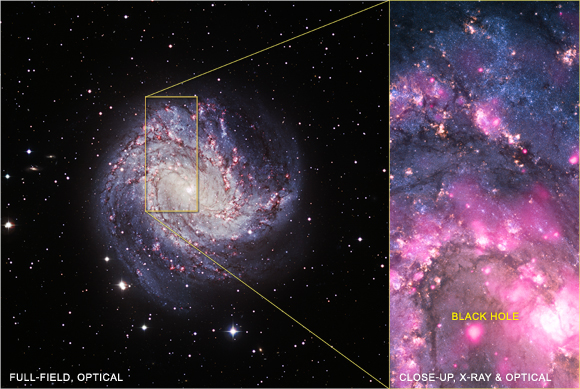
A black hole is formed when a massive star is squashed into an incredibly tiny volume. (The equivalent of squeezing the Earth into the size of a marble!) Packing so much material in such a small space gives black holes a superpower: Incredibly strong gravity that can even swallow-up light forever if it gets too close!
Around the danger zone, before disappearing forever into the black hole, any nearby material is accelerated to very high speeds. This fast-moving material gives off X-rays, which astronomers can observe using special telescopes in space.
Of course, there should be a limit to even a superhero's powers. But in recent years, astronomers have discovered regions around black holes that are giving off a crazy amount of X-rays - a lot more than what should be possible. In the galaxy pictured above, which is called M83, astronomers have discovered such a weirdly powerful black hole.
Astronomers still don't fully understand what is making these black holes mega-powerful, but it could be that they are much heavier than normal black holes. A heavy black hole could pull in more material than a smaller black hole, which would make a lot more X-rays. Instead of being a few times heavier than the Sun, like normal black holes, the mega-powerful ones could be up to 100 times heavier!
Cool fact: The black hole in the galaxy M83 is now producing 3000 times more X-rays than it had been before it became mega-powerful!
More information
This Space Scoop is based on a NASA Chandra X-ray Observatory Press Release.
Image Credit: Left image - Optical: ESO/VLT; Close-up - X-ray: NASA/CXC/Curtin University/R.Soria et al., Optical: NASA/STScI/Middlebury College/F.Winkler et al.
Watch the video podcast
Do you want to learn more about this topic?
Visit the Chandra field guide or send us your questions in an email: cxcpub@cfa.harvard.edu
In cooperation with Space Scoop: Bringing news from across the Universe to children all around the world. Universe Awareness and the Chandra X-ray Observatory
| Children & Online Privacy |



